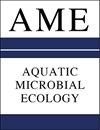A phosphate starvation response gene (psr1-like) is present and expressed in Micromonas pusilla and other marine algae
IF 1.1
4区 环境科学与生态学
Q3 ECOLOGY
引用次数: 0
Abstract
ABSTRACT: Phosphorus (P) limits primary production in regions of the surface ocean, and many plankton species exhibit specific physiological responses to P deficiency. The metabolic response of Micromonas pusilla, an ecologically relevant marine photoautotroph, to P deficiency was investigated using metabolomics and comparative genomics. The concentrations of some intracellular metabolites were elevated in the P-deficient cells (e.g. xanthine, inosine), and genes involved in the associated metabolic pathways shared a predicted conserved amino acid motif in the non-coding regions of each gene. The presence of the conserved motif suggests that these genes may be co-regulated, and the motif may constitute a regulatory element for binding a transcription factor, specifically that of Psr1 (phosphate starvation response). A putative phosphate starvation response gene ( psr1-like) was identified in M. pusilla with homology to well characterized psr1/ phr1 genes in algae and plants, respectively. This gene appears to be present and expressed in other marine algal taxa (e.g. Emiliania huxleyi) in field sites that are chronically P limited. Results from the present study have implications for understanding phytoplankton taxon-specific roles in mediating P cycling in the ocean.一个磷酸饥饿反应基因(psr1样)在pusilla小单胞菌和其他海藻中存在并表达
摘要:磷(P)限制了海洋表层区域的初级生产,许多浮游生物物种对磷缺乏表现出特定的生理反应。利用代谢组学和比较基因组学研究了海洋光自养微单胞菌(Micromonas pusilla)对缺磷的代谢反应。在缺磷细胞中,一些细胞内代谢物(如黄嘌呤、肌苷)的浓度升高,参与相关代谢途径的基因在每个基因的非编码区共享一个预测的保守氨基酸基序。保守基序的存在表明这些基因可能是共同调控的,并且该基序可能构成结合转录因子的调控元件,特别是Psr1(磷酸盐饥饿反应)。在pusilla中发现了一个推测的磷酸饥饿反应基因(psr1样基因),该基因与藻类和植物中的psr1/ phr1基因同源。该基因似乎存在于其他海洋藻类分类群(如赫胥黎Emiliania huxleyi)中,并在长期磷限制的野外地点表达。本研究的结果对理解浮游植物在海洋中调节磷循环的分类特异性作用具有重要意义。
本文章由计算机程序翻译,如有差异,请以英文原文为准。
求助全文
约1分钟内获得全文
求助全文
来源期刊

Aquatic Microbial Ecology
环境科学-海洋与淡水生物学
CiteScore
3.30
自引率
0.00%
发文量
8
审稿时长
3.0 months
期刊介绍:
AME is international and interdisciplinary. It presents rigorously refereed and carefully selected Research Articles, Reviews and Notes, as well as Comments/Reply Comments (for details see AME 27:209), Opinion Pieces (previously called ''As I See It'') and AME Specials. For details consult the Guidelines for Authors. Papers may be concerned with:
Tolerances and responses of microorganisms to variations in abiotic and biotic components of their environment; microbial life under extreme environmental conditions (climate, temperature, pressure, osmolarity, redox, etc.).
Role of aquatic microorganisms in the production, transformation and decomposition of organic matter; flow patterns of energy and matter as these pass through microorganisms; population dynamics; trophic interrelationships; modelling, both theoretical and via computer simulation, of individual microorganisms and microbial populations; biodiversity.
Absorption and transformation of inorganic material; synthesis and transformation of organic material (autotrophic and heterotrophic); non-genetic and genetic adaptation; behaviour; molecular microbial ecology; symbioses.
 求助内容:
求助内容: 应助结果提醒方式:
应助结果提醒方式:


